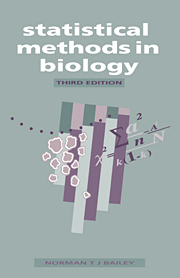Book contents
- Frontmatter
- Contents
- Preface
- 1 Introduction
- 2 Variability and frequency distributions
- 3 Estimation, standard errors and confidence limits
- 4 The basic idea of a significance test
- 5 Simple significance tests based on the normal distribution
- 6 The use of t-tests for small samples
- 7 Contingency tables and χ2
- 8 χ2-tests of goodness-of-fit and homogeneity
- 9 The correlation of measurements
- 10 Regression analysis
- 11 Simple experimental design and the analysis of variance
- 12 Introduction to factorial experiments
- 13 Random samples and random numbers
- 14 Partial correlation and multiple regression
- 15 Non-parametric and distribution-free tests
- 16 Notes on numerical calculation, calculators and computers
- Suggestions for more advanced reading
- Summary of statistical formulae
- Appendix tables
- Index
10 - Regression analysis
Published online by Cambridge University Press: 05 June 2012
- Frontmatter
- Contents
- Preface
- 1 Introduction
- 2 Variability and frequency distributions
- 3 Estimation, standard errors and confidence limits
- 4 The basic idea of a significance test
- 5 Simple significance tests based on the normal distribution
- 6 The use of t-tests for small samples
- 7 Contingency tables and χ2
- 8 χ2-tests of goodness-of-fit and homogeneity
- 9 The correlation of measurements
- 10 Regression analysis
- 11 Simple experimental design and the analysis of variance
- 12 Introduction to factorial experiments
- 13 Random samples and random numbers
- 14 Partial correlation and multiple regression
- 15 Non-parametric and distribution-free tests
- 16 Notes on numerical calculation, calculators and computers
- Suggestions for more advanced reading
- Summary of statistical formulae
- Appendix tables
- Index
Summary
THE BASIC IDEA OF REGRESSION
In the previous chapter we saw how the association between two measurements, such as the statures of father–son pairs or the heights and weights of a series of individuals, could be calculated in terms of the correlation coefficient. For this procedure to be reasonably satisfactory it was necessary that the two measurements followed a bivariate normal distribution, at least approximately. With heights and weights, for instance, and many other physical measurements, the assumption is probably not too far from the truth. In general, if we select individuals at random and make measurements on them, or alternatively select some randomly chosen unit such as a family, then the pairs of readings certainly have a bivariate distribution of some kind. With luck it will also be approximately bivariate normal. If, however, we specially select individuals on the basis of one measurement and afterwards record the other, the first measurement properly speaking has no distribution: it may have been decided quite arbitrarily.
Thus, the data in Table 14 are quite suitable for the correlation type of analysis: a family is randomly chosen, and the father and one son (also randomly chosen) are measured. Suppose now that we were specially interested in the sons of very tall and very short fathers. We might well consider that Table 14 contained insufficient material about these extremes, and might decide to swell the sample by an extra 100 fathers of about 1.58 m in height and another 100 of about 1.84 m.
Information
- Type
- Chapter
- Information
- Statistical Methods in Biology , pp. 104 - 114Publisher: Cambridge University PressPrint publication year: 1995
Accessibility standard: Unknown
Why this information is here
This section outlines the accessibility features of this content - including support for screen readers, full keyboard navigation and high-contrast display options. This may not be relevant for you.Accessibility Information
- 1
- Cited by
